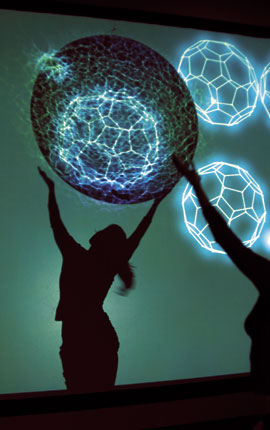|
|
|
|
|
||||||
LACMA exhibit brings together science, art
DAILY BRUIN CONTRIBUTOR rcortado@media.ucla.edu When Victoria Vesna and Jim Gimzewski began engineering the interactive, all-ages exhibit "nano" at the Los Angeles County Museum of Arts' Boone Children's Gallery, they did not anticipate aggressive children breaking the cameras and microphones or getting lodged in the tunnel-like kaleidoscope. Gimzewski, a chemistry professor at UCLA, takes all these technical difficulties in stride. "I just love the sense of freedom and fun where all the restraints (of 'don't touch') you normally have in a museum are gone," said Gimzewski. With all these malfunctions and children running around screaming inside the "Quantum Tunnel," do the little ones or even their adult counterparts understand the connections between nanotechnology and the exhibits? The creators, hailing from various departments at UCLA, stressed that their intention is to create a fun experience rather than an instructive science exhibit, especially since there are few known facts in the field of nanotechnology. "We wanted to provoke imagination, visions, thinking, questioning," said Vesna, a UCLA Design | Media Arts professor and the department chair. As children play with the geometric connector sets on a mirrored table, adults are challenged on a different level, interpreting quotes pulled from science fiction, literature and academic texts compiled by English Professor Katherine Hayles. For those who want to explore nanotechnology more deeply, Hayles is editing a collection of essays discussing the cultural implications of this new science to be released in April. The free exhibit, ongoing until September and inspired by the new field of science, nanotechnology, invites visitors into a sensory experience of sound and touch. Multiple speakers emit a symphony of melodic humming sounds from different directions as the visitor treads through dark spaces and push buckyballs across a projected screen with their shadows. In the "nano" exhibit, where a nanometer is a billionth of a meter, creative thinking becomes increasingly important in exploring this field as Newtonian physics no longer apply on the molecular level. Andrew Pelling, a third-year graduate student in chemistry who contributed to the sound component of the exhibit and aids in its maintenance, explains that as nanoscience is in an experimental state, "(the exhibit itself) is an experiment. It is something that changes and throwing in all these kids takes out the theory in the process of what works best." "Nano" relies on computer technology that is never 100 percent efficient. Since the opening, the already-sturdy cameras and microphones enclosed in plastic spheres and connected to a movable tube in the "Quantum Tunnel" exhibit broke from children banging the two spheres together, and the wires inside the tube shredded from excessive bending. Kids try to climb on and toss the 3-foot robotic white balls in the "inner cell" installation, so it is difficult to make the association that the balls are remote controlled by trackballs on a table found on the outside of the cell. In the same way that "Nano" connects generations of art enthusiasts, the creators of the exhibit wanted to bridge the gaps between north and south campus. Master of Fine Arts Design | Media Arts student Anne Niemetz and Pelling, who met working on the sound component of "nano" along with undergraduate media arts student Tenzin Wanchuk, are using the ideas from "nano" in collaborating on Niemetz' thesis. They will stage a concert this spring called, "The Dark Side of the Cell." "Stage presentation has to change with electronic music. Most of the time (during the concert), we're not going to be physically present, so it's going to be a journey to get the visitor to be immersed in the experience," said Niemetz. |
| Printable Version |
| Click here for a printable version of this article. |
| Contact Us |
| Email Arts & Entertainment at ae@ media.ucla.edu for questions or concerns about this article. |
|
|||

